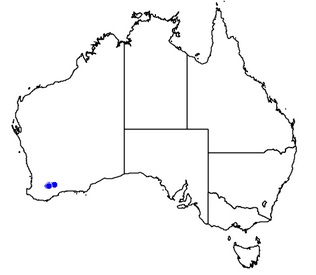Difference between revisions of "Acacia depressa"
(Created page with "== General Plant Info == Acacia depressa, also known as "Echidna Wattle" is a distinctive species on account of its prostrate habit, spinescent branchlets and unijugate le...") |
(→Geographic distribution) |
||
| Line 8: | Line 8: | ||
The prostrate form and summer flowering may have resulted in the species being overlooked (Maslin, pers. comm. in Leigh et al. 1984). The species is conserved in Tarin Rock NR (Leigh et al. 1984; Briggs & Leigh 1996) but is bisected by a road. The surviving plants were not considered secure by Leigh et al. (1984). | The prostrate form and summer flowering may have resulted in the species being overlooked (Maslin, pers. comm. in Leigh et al. 1984). The species is conserved in Tarin Rock NR (Leigh et al. 1984; Briggs & Leigh 1996) but is bisected by a road. The surviving plants were not considered secure by Leigh et al. (1984). | ||
| − | + | [[File:depressa-map.jpg]] | |
'''Beard’s Provinces''': South-West Province. | '''Beard’s Provinces''': South-West Province. | ||
Latest revision as of 04:00, 3 February 2015
Contents
General Plant Info
Acacia depressa, also known as "Echidna Wattle" is a distinctive species on account of its prostrate habit, spinescent branchlets and unijugate leaves with long petioles. Published as a rare species in W.A, it is a prostrate, dense, prickly shrub, 0.02-0.15 m high, 50cm wide diameter. Flowers between December to January.
Geographic distribution
The species is only known from the area of the type locality (Maslin 1975), lateritic hills between Kukerin and Tarin Rock (Maslin 1975; Leigh et al. 1984), in the Duggan area (Brown et al. 1998), west of Lake Grace (Hopper et al. 1990; Brown et al. 1998; Orchard & Wilson 2001a), Katanning District, south-western WA (Graham & Mitchell 2001). The prostrate form and summer flowering may have resulted in the species being overlooked (Maslin, pers. comm. in Leigh et al. 1984). The species is conserved in Tarin Rock NR (Leigh et al. 1984; Briggs & Leigh 1996) but is bisected by a road. The surviving plants were not considered secure by Leigh et al. (1984).
Beard’s Provinces: South-West Province.
IBRA Regions: Mallee.
IBRA Subregions: Western Mallee.
Local Government Areas (LGAs): Dumbleyung, Lake Grace.
Identification
Prostrate, forming mats to 5 cm high and 0.5 m or more across. Branchlets spinose, sparsely appressed-puberulous.
Phyllodes are bipinnate, glabrous; pinnae 1 pair, 2- 4 mm long; petiole 3- 4 mm long; pinnules 3- 4 pairs, narrowly oblong to oblong-oblanceolate, 2- 3 mm long, c. 1 mm wide, asymmetrically narrowed at apex, milky green to subglaucous; gland near distal end of petiole, sessile.
Inflorescences simple, 1 per axil; peduncles 10- 20 mm long, glabrous or appressed-puberulous; heads globular, 12- 15-flowered, light golden. Flowers 5-merous; sepals c. 3/4-united.
Pods narrowly oblong, 1- 2 cm long, c. 3 mm wide, firmly chartaceous; margins somewhat thickened.
Seeds not seen.
Alkaloid content
Extraction
Other uses
Cultivation
Lateritic gravelly soils.
Good seed germination has been noted following early autumn fires (Brown et al. 1998). Low seedling numbers occur following disturbance (Graham & Mitchell 2001).
Suppliers
Links
http://www.worldwidewattle.com/speciesgallery/depressa.php?id=3295
https://florabase.dpaw.wa.gov.au/browse/profile/3295
http://www.environment.gov.au/cgi-bin/sprat/public/publicspecies.pl?taxon_id=5685
